Georgetown lost yet another of its exquisite architectural structures, when the former Bureau of Statistics Office, on High Street and Brickdam, opposite the Parliament Building, was demolished in November 2010. Adding to its ignominious demise, is the fact that its origin is in dispute, with no DNA possible. This is worse than going to your funeral without knowing who your father is!
In a letter to Stabroek News the following was proferred by Lloyd Marshall:
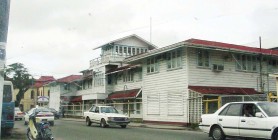
“During the war years (WWII), Mackenzie Airport with its 5000-foot paved runway was utilized for commercial flights. The airport terminal building was the same structure which was shown being demolished on the front page of the November 16 edition. It was subsequently dismantled, transported to Georgetown and re-assembled opposite the Parliament.”
This Nostalgia buff, ever vigilant to preserve our social and cultural history in the twentieth century, begged to differ, and recorded this version of this saga:

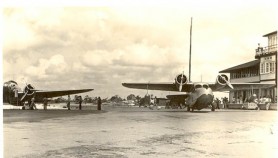
“At this time, the bauxite production of Mackenzie, Suriname and Jamaica, plus the oil from Trinidad, Curacao and Aruba were vital to the war effort of the Allies. Indeed many years later, our bauxite workers at Wismar often boasted ‘their production effort won the war.’ Over 400 ships were destroyed in this hemisphere, and I remember then the US Zepplin flying daily overhead Georgetown in the morning, returning before dusk, to reconnoitre our foreshore. After 1945, when the war ended, the Atkinson Airfield became commercial.
“The Mackenzie Airport was constructed at the same with a huge concrete airstrip and a small guard hut. At this time, a seaplane landing facility was also available at Makouria, opposite Bartica as a back-up base. After the surprise Pearl Harbour attack Uncle Sam was not going to be caught ‘pants down.’”
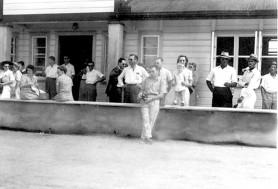
At the Mackenzie Field, designated an ‘aero-drome,’ commercial flights and international flights landed there and passengers were shuttled to Ruimveldt. Art Williams, limited with his small five-seater Wasp Ireland NC 183 seaplane, had registered a private company, BG Airways Ltd on May 27, 1938, and in 1944, the company received from government a special subsidy to purchase a Grumman Amphibian NC 39084 to sustain and expand air services in British Guiana.
In August 1946, another advance was granted to purchase two Douglas DC 3 (C47) freighter planes which were flown into the colony in November 1946 and March 1947. As interior air services expanded, a second Grumman amphibian was purchased. By October 26, 1953, the airport was handed over to the government and the responsibility of Atkinson airfield vested in the hands of the Director of Civil Aviation (Lloyd Kandasammy Brief History of Civil Aviation in Guyana, 2004).
In 1955, government purchased the aviation assets of Art Williams’s company which then became the BG Airways (government). In August 1959 the Atkinson Field terminal was destroyed by fire, and the old US terminal on the other side of the field was utilized, pending the rebuilding of a new airport. Peter Halder, former Guyana diplomat, my counsel in this matter, adds that “major additions were made to the Airport Terminal at Timehri in 1965 and 1968, which was named Timehri Internation-al, May 1969. The Terminal became the Cheddi Jagan Inter-national Airport Oct 5, 2001.”
At this time, transportation to the bauxite town was a lumbering eight-hour river trip by the RH Carr which was put into service in 1927, and converted to diesel at Sprostons Dry Dock in the fifties. Demba procured two launches MV Polaris and MV Kara Kara for faster river trips by staff to Georgetown. They did buy a De Haviland Otter in the sixties, and the watch hut was replaced by a hangar only. A seaplane landing was also available off Watooka.
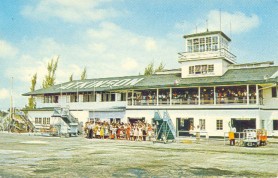
Was there ever a terminal building at the Mackenzie Air-port? None is indicated in any of the available pictures re this facility. One shows passengers with vehicles actually loading cargo and boarding the Dakota on the tarmac at Mackenzie.
Demba’s expansion in bauxite production peaked in 1952 becoming our second major industry, employing 3000 people and contributing $2 million to the country’s revenue. Two new kilns were constructed that year to produce calcined bauxite and quicken the drying process. By the end of 1960 bauxite accounted for over 60% of our gross domestic product.
The area was thriving with massive improvements to hospital and clinical services; technical and scholastic training expanded with the Trade School; the Crescent cinema opened in 1952; and a field for the new Mackenzie Sports Ground was prepared.
I mention all of this if only to query the justification for demolishing the terminal building at Mackenzie (if there was one) and transferring it to Georgetown. Even so, would a replacement not have been necessary in the expanding conditions in the mining sector?
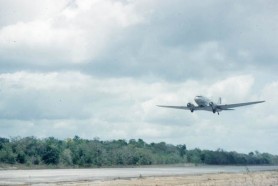
Certainly Demba would not have been cash strapped, and their major gift to the local government was not until 1966, namely, the Independence Arch on Brickdam. The transportation of the demolished building materials would have been a nightmare – logistically challenging – but was possible (if there was a terminal) by barge. The first all-aluminium boat in the world, MV Independence built by Sprostons was commissioned 1966. The Linden Highway was opened December 1968 facilitating road transportation.
The demolished Statistics Bureau was formerly the Ministry of Works and Communica-tions and was built by 1953; it was there when I started my civil service career on June 15, 1955. If this building was transferred from Mackenzie, then this must have occurred between 1945 and some time before 1953. To support my contention that there was never a terminal at Macken-zie, I solicited and received the following:
In the ’50s and ’60s British Guiana Airways sometimes flew scheduled runs to the airfield at Mackenzie using DC3s and the Grumman Goose. At this time there was a guard hut at the airstrip probably operated and maintained by Demba. The BG Airways service was discontinued in the mid ’60s when Demba acquired its own plane, a DeHaviland Otter. The Otter was based at the Mackenzie airfield. Demba built a substantial hanger for the Otter at the airfield replacing the guard hut. The hanger disappeared from the airfield with the demise of Demba in the ’70s.
The Mackenzie airfield was a substantial construction, wide lengthy and properly paved, totally out of place in the middle of the bush. For a long time it was the only paved thing in Mackenzie. I’ve seen modern photos of that airfield and it is still going strong without any maintenance since it was built. As a boy, I was told it was built during WWII for the defence of the bauxite industry by the Americans, at the same time that Atkinson airfield was built.
I’ve always had a hard time imagining the Americans building the Mackenzie airfield without some sort of building; the airfield is just too substantial. But by the ’50s there wasn’t anything left. Hard to imagine any war buildings being moved to GT without a road. They would have had to use barges on the Demerara, meaning that only the construction materials could have been transferred. Any building would have to have been reconstructed…
A senior officer of the district administration office, Christian-burg, during the sixties also submitted:
I was born in Mackenzie in the 1930s and grew up there. I now live in Ontario, Canada. There was an airstrip and not an airport at Mackenzie; the airstrip was located on a hill (not Richmond Hill) about 4 miles south-east of Mackenzie; I was a cub-scout and visited the airstrip from time to time in the ’40s; and picknicked there some Sundays during the 1940s. The airstrip had no terminal building; there was a small guard hut in which a constable kept security. The airstrip was used mostly by DEMBA’s Canadian expatriate top executives for a speedy trip instead of using the RH Carr or its luxury launches the MV Kara or the MV Polaris. So my friend, if there was no airport or airport terminal building, the latter could not have been transferred…
On Sunday, November 21 a reader posted on the blog in response to my letter in the SN the original two pictures supplied to Stabroek News which were published. These pictures were posted on Facebook on February 12, 2008, and both carried a caption purporting there had been a transfer.
The High Street taxi in the Georgetown picture is a City Taxi, and is therefore recent. The other picture shows a Grumman plus two other aeroplanes and lots of spectators. Enlarge-ments plus a magnifying glass reveal buildings in the background, plus a BWIA baggage cart. This picture seems more like operations at Atkinson Field after the 1959 fire.
Is it possible that when the pictures were posted together on Facebook the conclusion was reached that they were the same building because of the control tower? The two buildings are not the same except for the similar towers. The tower on the High Street building could have been the architect’s ornamentation for the Ministry of Commu-nication and Works there.
I am still to fathom the justification for transferring the terminal building at a time when Demba’s expansion was peaking. The foregoing facts are produced here for readers to judge for themselves.
The solution
It was Rod Grimes-Graeme, a former Guyanese pilot now resident in Antigua who brought an end to the controversy, and came up with the evidence and recollections to demonstrate that the Mackenzie Airport terminal was indeed moved to High Street, persuasive arguments to the contrary notwithstanding.
He sent the following:
I have attached the pictures from our family album that convince me that the two buildings are the same – one taken in 1946 in Mackenzie and one taken in 2002 in Georgetown. The third one shows a group of Demba expats, and I am the little boy being held up by my mother. This was taken June 30, 1943. We were there to say goodbye to one of our teachers who was going back to Canada. I lived in Mackenzie from 1945 to 1952 and that building was there all the time. When I returned to Mackenzie in 1965 it was gone. I was told it had been taken apart and rebuilt in Georgetown. It was later shown to me by a Demba employee…
For more Nostalgias go to Godfrey Chin at Google/ Yahoo or refer to Godfrey’s Nostalgias – Golden Memories of Guyana 1940 to 1980 available at Austin’‘s Bookstore or Shell, Vlissengen Road.




